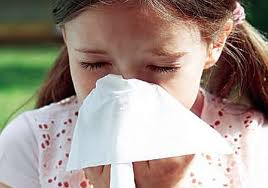 A common cold is normally a harmless viral infection that affects the nose and throat which forms the respiratory tract of the human body. It causes watery eyes, sneezing and congestion and can also cause cough, a runny nose and even a sore throat. Since there are more than 100 different strains of the virus, therefore the symptoms of common cold vary a lot. Normally, common cold does not require patients to go to their physician. However, common cold can lead to some serious complications. You should consult with your doctor early if you have.
A common cold is normally a harmless viral infection that affects the nose and throat which forms the respiratory tract of the human body. It causes watery eyes, sneezing and congestion and can also cause cough, a runny nose and even a sore throat. Since there are more than 100 different strains of the virus, therefore the symptoms of common cold vary a lot. Normally, common cold does not require patients to go to their physician. However, common cold can lead to some serious complications. You should consult with your doctor early if you have.
Common Cold Complications
1. Sore Throat and Tonsillitis
 Sore throat is a common problem associated with common cold. It makes swallow food or water difficult. Though sore throat is mostly caused by common cold, sometimes it can also be caused by a common bacterial infection called streptococcus bacteria. Another reason for sore throat can be tonsillitis which can be caused by either a virus ora bacterium. In case your sore throat is not healing and the pain you feel is not going away, you must consult your physician.
Sore throat is a common problem associated with common cold. It makes swallow food or water difficult. Though sore throat is mostly caused by common cold, sometimes it can also be caused by a common bacterial infection called streptococcus bacteria. Another reason for sore throat can be tonsillitis which can be caused by either a virus ora bacterium. In case your sore throat is not healing and the pain you feel is not going away, you must consult your physician.
2. Sinus Infection
 Usually sinuses in humans are filled with air, but when the nose is runny, the sinus gets filled with fluid. Bacteria grow in such environment and cause an infection. A sinus infection is the swelling of sinus because of an infection. The common cold symptoms, like nasal congestion and blockage, block off the nasal passage, leaving it prone to infection.
Usually sinuses in humans are filled with air, but when the nose is runny, the sinus gets filled with fluid. Bacteria grow in such environment and cause an infection. A sinus infection is the swelling of sinus because of an infection. The common cold symptoms, like nasal congestion and blockage, block off the nasal passage, leaving it prone to infection.
In case sinus infection develops, following are its symptoms:
Nasal discharge which is thick and yellow and has a very bad odor
- Headache
- Fever and cough
- Post nasal drip, nasal congestion and obstruction
- Pain near the eyes and cheeks
If any of the above symptoms develop, you should immediately consult your doctor to find out if you have sinusitis or not.
3. Ear Infection
 Ear infection is a complication that occurs along with the common cold, mostly in children and young babies. When cold virus or bacteria enter the region behind the ear drum, the ear infection happens. Ear infection causes severe pain and aching in the ear. The following are the major symptoms and signs of ear infection:
Ear infection is a complication that occurs along with the common cold, mostly in children and young babies. When cold virus or bacteria enter the region behind the ear drum, the ear infection happens. Ear infection causes severe pain and aching in the ear. The following are the major symptoms and signs of ear infection:
- Severe pain
- A fever more than 100oF
- Nausea, vomiting and weakness
- A decrease in the sense of hearing
- In case ear infection occurs in a child, he can also have a nasal discharge of green or yellow color.
In most cases of ear infection, the infection goes away in three days. If the infection remains more than three days, it is necessary to contact the doctor immediately.
4. Asthma
.jpg) Common cold is an infection caused by a virus affecting the upper respiratory tract of the human body. Asthma on the other hand is caused by the inflammation of the lower airways of the human body which are inside the lungs. This is the reason why common cold can trigger the patient's asthma if he or she has. The following are the main symptoms of asthma:
Common cold is an infection caused by a virus affecting the upper respiratory tract of the human body. Asthma on the other hand is caused by the inflammation of the lower airways of the human body which are inside the lungs. This is the reason why common cold can trigger the patient's asthma if he or she has. The following are the main symptoms of asthma:
- Congestion in chest
- Getting breathless or out of breath
- Recurrent coughing
- Wheezing
You should get into contact with your physician as soon as possible if you have any symptoms below:
- A high fever more than 101oF
- A lot of weakness, tiredness and lethargy
- More than usual difficulty in swallowing food and a sore throat
- Discharge of green and yellow colored mucus in a large quantity while coughing
- Pain and aching in the cheekbones
- Headaches
- Toothaches
5. Chest Infection
 As your immune system is weakened after a common cold, chest infections can happen after cold. Bronchitis and pneumonia are two major kinds of chest infections. Pneumonia is a rare infection but has serious symptoms, whereas bronchitis itself disappears after a few weeks.
As your immune system is weakened after a common cold, chest infections can happen after cold. Bronchitis and pneumonia are two major kinds of chest infections. Pneumonia is a rare infection but has serious symptoms, whereas bronchitis itself disappears after a few weeks.
Bronchitis
Cough is a common symptom of cold and is a tactic used by body to discharge mucus and phlegm. However, if the cough does not go away with the cold and thick green or yellow phlegm is getting discharged with coughing, you might have bronchitis. It causes inflammation in the lung airways, producing a significantly large amount of mucus. The most common bronchitis’ symptoms include:
- Lethargy and lack of energy
- Breathing accompanied by a sound as if you are out of breath
- Fever
- Persistent coughing along with mucus
If your fever is more than 101oF or blood is coming out with cough you must visit your physician as soon as possible.
Pneumonia
Pneumonia is an infection of lungs and can happen at any age. The infection can be either bacterial or viral. A common cold or flu can cause pneumonia if it lasts longer because cold will cause irritation in the lungs and thus makes it easier for the bacteria or the virus to cause the infection. Following are the main symptoms which appear with a pneumonia infection:
- Sweating, shaking because of chill fever
- Body temperature becomes lower than normal in people with weak immune system and those more than 65 years old.
- Pain in the chest while breathing and coughing
- Production of sticky fluid while coughing
- Getting out of breath
- Pain in the head
- A feeling of nausea, vomiting and diarrhea
In case you have symptoms like consistent fever of more than 102oF, difficulty in breathing, chest pain you must immediately get advice from your physician. If a child or an aged person shows any sign of pneumonia, he/she should be immediately taken to the hospital.


